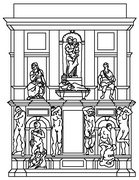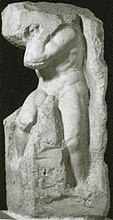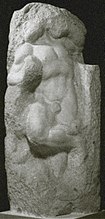
Michelangelo di Lodovico Buonarroti Simoni, known mononymously as Michelangelo, was an Italian sculptor, painter, architect, and poet of the High Renaissance. Born in the Republic of Florence, his work was inspired by models from classical antiquity and had a lasting influence on Western art. Michelangelo's creative abilities and mastery in a range of artistic arenas define him as an archetypal Renaissance man, along with his rival and elder contemporary, Leonardo da Vinci. Given the sheer volume of surviving correspondence, sketches, and reminiscences, Michelangelo is one of the best-documented artists of the 16th century. He was lauded by contemporary biographers as the most accomplished artist of his era.

Moses is a sculpture by the Italian High Renaissance artist Michelangelo, housed in the church of San Pietro in Vincoli in Rome. Commissioned in 1505 by Pope Julius II for his tomb, it depicts the biblical figure Moses with horns on his head, based on a description in chapter 34 of Exodus in the Vulgate, the Latin translation of the Bible used at that time. Some scholars believe the use of horns may often hold an antisemitic implication, while others hold that it is simply a convention based on the translation error.

The Sistine Chapel ceiling, painted in fresco by Michelangelo between 1508 and 1512, is a cornerstone work of High Renaissance art.
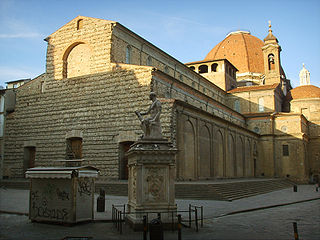
The Basilica di San Lorenzo is one of the largest churches of Florence, Italy, situated at the centre of the main market district of the city, and it is the burial place of all the principal members of the Medici family from Cosimo il Vecchio to Cosimo III. It is one of several churches that claim to be the oldest in Florence, having been consecrated in 393 AD, at which time it stood outside the city walls. For three hundred years it was the city's cathedral, before the official seat of the bishop was transferred to Santa Reparata.

Sebastiano del Piombo was an Italian painter of the High Renaissance and early Mannerist periods famous as the only major artist of the period to combine the colouring of the Venetian school in which he was trained with the monumental forms of the Roman school. He belongs both to the painting school of his native city, Venice, where he made significant contributions before he left for Rome in 1511, and that of Rome, where he stayed for the rest of his life, and whose style he thoroughly adopted.
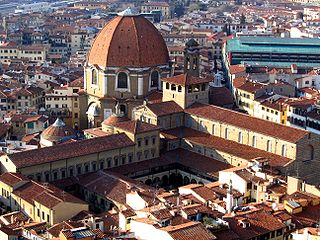
The Medici Chapels are two chapels built between the 16th and 17th centuries as an extension to the Basilica of San Lorenzo, in the Italian city of Florence. They are the Sagrestia Nuova, designed by Michelangelo, and the larger Cappella dei Principi, a collaboration between the Medici family and architects. The purpose of the chapels was to celebrate the Medici family, patrons of the church and Grand Dukes of Tuscany.
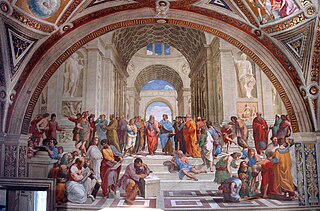
Pope Julius II, commissioned a series of highly influential art and architecture projects in the Vatican. The painting of the Sistine Chapel ceiling by Michelangelo and of various rooms by Raphael in the Apostolic Palace are considered among the masterworks that mark the High Renaissance in Rome. His decision to rebuild St Peter's led to the construction of the present basilica.
Raffaello da Montelupo, born Raffaele Sinibaldi, was a sculptor and architect of the Italian Renaissance, and an apprentice of Michelangelo. He was the son of another Italian sculptor, Baccio da Montelupo. Both father and son are profiled in Vasari's Le Vite delle più eccellenti pittori, scultori, ed architettori.

The Crucifixion of Saint Peter is a fresco painting by the Italian Renaissance master Michelangelo Buonarroti. It is housed in the Cappella Paolina, Vatican Palace, in the Vatican City, Rome. It is the last fresco executed by Michelangelo.
The Dying Slave is a sculpture by the Italian Renaissance artist Michelangelo. Created between 1513 and 1516, it was to serve with another figure, the Rebellious Slave, at the tomb of Pope Julius II. It is a marble figure 2.15 metres in height, and is exhibited at the Louvre, Paris.

The Battle of Cascina is a never-completed painting in fresco commissioned from Michelangelo for the Palazzo Vecchio in Florence. He created only the preparatory drawing before being called to Rome by Pope Julius II, where he worked on the Pope's tomb; before completing this project, he returned to Florence for some months to complete the cartoon.
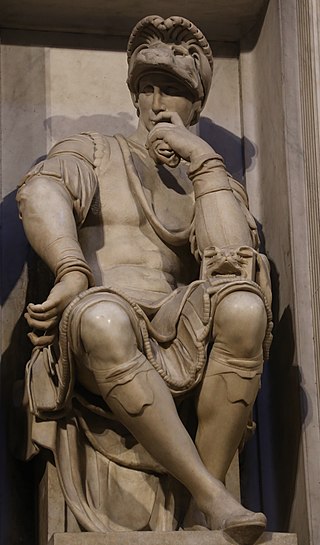
Michelangelo had a complicated relationship with the Medici family, who were for most of his lifetime the effective rulers of his home city of Florence. The Medici rose to prominence as Florence's preeminent bankers. They amassed a sizable fortune some of which was used for patronage of the arts. Michelangelo's first contact with the Medici family began early as a talented teenage apprentice of the Florentine painter Domenico Ghirlandaio. Following his initial work for Lorenzo de' Medici, Michelangelo's interactions with the family continued for decades including the Medici papacies of Pope Leo X and Pope Clement VII.

The Young Slave is a marble sculpture of Michelangelo, datable to around 1525–1530 which is conserved in the Galleria dell'Accademia in Florence. It is part of the "unfinished" series of Prigioni intended for the Tomb of Julius II.
The Bearded Slave is a marble sculpture by Michelangelo datable to around 1525–1530 and kept in the Galleria dell'Accademia in Florence. It forms part of the series of unfinished Prigioni intended for the Tomb of Pope Julius II.

The Atlas Slave is a 2.77m high marble statue by Michelangelo, dated to 1525–1530. It is one of the 'Prisoners', the series of unfinished sculptures for the tomb of Pope Julius II. It is now held in the Galleria dell'Accademia in Florence.

The Awakening Slave is a 2.67m high marble statue by Michelangelo, dated to 1525-1530. It is one of the 'Prisoners', the series of unfinished sculptures for the tomb of Pope Julius II. It is now held in the Galleria dell'Accademia in Florence.
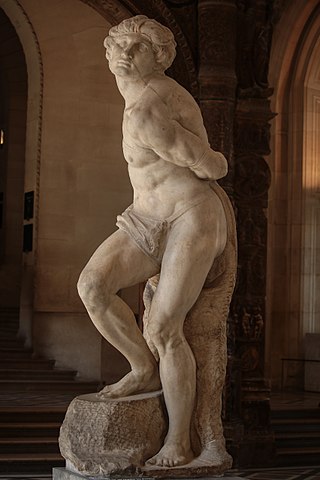
The Rebellious Slave is a 2.15m high marble statue by Michelangelo, dated to 1513. It is now held in the Louvre in Paris.
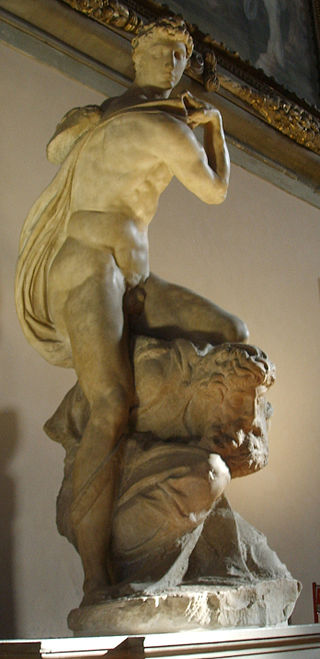
The Genius of Victory is a 1532–1534 marble sculpture by Michelangelo, produced as part of a design for the tomb of Pope Julius II. It is 2.61 m high and is now in the Salone dei Cinquecento of the Palazzo Vecchio in Florence.
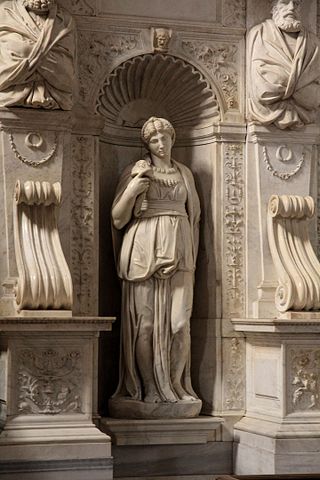
Leah is a sculpture by Michelangelo of the Old Testament figure Leah. Like the artist's Rachel, it was part of the final, 1542–1545 design for the tomb of Pope Julius II in San Pietro in Vincoli, on which it still remains.

The Sagrestia Nuova, also known as the New Sacristy and the Medici Chapel, is a mausoleum that stands as a testament to the grandeur and artistic vision of the Medici family. Constructed in 1520, the mausoleum was designed by the Italian artist Michelangelo. Situated adjacent to the Basilica di San Lorenzo in Florence, Italy, the Sagrestia Nuova forms an integral part of the museum complex known as the Medici Chapels.








